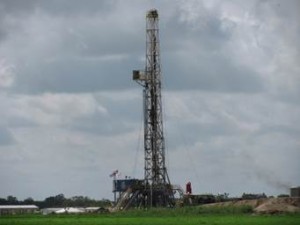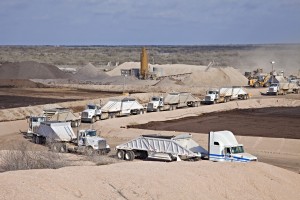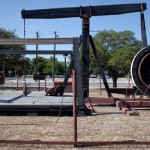Are Drilling Waste Pits a Threat to Texas Groundwater?

Dave Fehling / StateImpact Texas
Drilling for oil & gas can generate thousands of barrels of waste per well
In one of the hottest plays for natural gas drilling, Bob Patterson wonders if what the drilling industry leaves behind will come back to haunt the community.
“It’s just a ticking time bomb before we have major aquifer contamination,” Patterson told StateImpact.
Patterson manages the Upper Trinity Groundwater Conservation District. His office monitors the drilling industry in North Texas, home to the Barnett Shale, which is producing some of the greatest volumes of natural gas in the country.
Reserve Pits
Patterson’s fear is about what are called reserve pits. The earthen pits are dug on the site of a drilling rig. Into the pits go thousands of barrels-worth of drilling waste. The waste comes back up out of the well as the drill cuts thousand of feet down into the earth. The waste can be a muddy, oily mix of saltwater, sand, and drilling fluids and can contain chemicals and diesel fuel.
Texas does little to regulate the pits. For most reserve pits, Texas does not require permits or inspection. They can be left unlined (as compared with sanitary landfills for household trash which are extensively regulated). Texas rules do state that the pits shouldn’t pollute surface or groundwater.
“Generally speaking, it is a very precarious situation. It’s sort of a toss of a coin if the regulations have any effectiveness at all,” Patterson told StateImpact Texas.
Concern over Leaching
The pits have caused concern for decades. A 1987 national report to Congress by the U.S. Environmental Protection agency, which was recently published by the New York Times, said that “leaching of reserve pit constituents into ground water and soil is a problem in the Texas/Oklahoma zone. Reserve pit liners are generally not required in Texas and Oklahoma.” (Most states do not allow unlined pits according to an overview by a Houston law firm).
The EPA report said that without the benefit of a liner, there was a “higher potential” for pollution including “barium, chromium, and arsenic” to reach groundwater.
Six years ago, New Mexico issued a “pit rule” that all but banned drilling sites from using reserve pits that were dug near rigs. The drilling industry complained the ban was driving up the cost of drilling and prompting drillers to head to Texas. Last year, New Mexico relaxed some of the restrictions.
Alternatives to On-site Pits
Some of the major exploration companies have now stopped using pits in favor of “closed-loop” or “pitless” systems. The systems use big tanks in which drilling waste can be separated and, in some cases, recycled.
According to an emailed response from the Railroad Commission of Texas, which polices the drilling industry, “a common industry practice includes operators using above-ground steel tanks instead of reserve pits to store drilling fluids.” What percent of drilling operators are using the tanks the Railroad Commission didn’t specify.

Courtesy R360
R360 disposal and recycling site in South Texas
But according to R360 Environmental Solutions, a Woodlands-based company that hauls drilling waste to its own regulated and lined pits.
“Between 60 and 70 percent of the drilling waste generated is put in these reserve pits as opposed to being sent to a company like ours,” said Bradley Zarin, R360’s Director of Government Affairs.
“It doesn’t have to be buried on site. We have facilities that can handle all kinds of waste streams coming from the drilling process and dispose of that waste, treat it, or recycle it responsibly,” said Zarin. He said some of the drilling waste is converted to an asphalt base the Texas Department of Transportation uses to build roads.
Water Testing in North Texas
The Railroad Commission told StateImpact it does not know of “any confirmed groundwater contamination cases related to reserve pits.” Spokesperson Ramona Nye wrote in an emailed response that the risk is minimized by drillers who “will generally line these pits if there is a risk of fluid loss” that would be a violation of water pollution laws. Nye added that “drilling muds” as the fluids are also called, are “designed to build up an impermeable layer to prevent fluids from leaking out of a wellbore or a reserve pit.”
In North Texas, Bob Patterson, the groundwater conservation manager, said there have certainly been fears that waste might eventually leach into water supplies. But testing isn’t required of private wells and the district has a total of some 6,000 private and public wells registered in its four counties.
So now, the district is trying to collect at least 100 well water samples in four counties (Wise, Parker, Montague and Hood) and analyze them for chemicals used in the drilling process. The district is working with scientists at the University of Texas at Arlington. They hope to have results by this fall.

